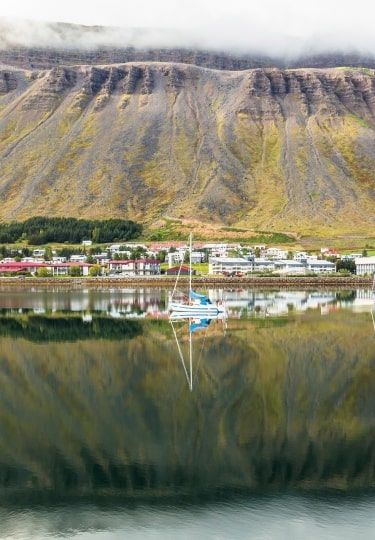Tiny Isafjordur, Iceland is the capital of the Westfjords, a frilled peninsula jutting out of the northwest coastline of Iceland. Steep, treeless hillsides have been scraped bare by glaciers over the millennia, and tiny fishing villages are dotted at the heads of sheltered inlets.
This is where you come for the great outdoors; kayaking, bird watching, horseback riding, and some of the best whale watching in Iceland.
Isafjordur may only have a population of 2,700, but it packs a punch when it comes to local culture, craft beer, colorful architecture, and a fascinating glimpse into the days when Iceland was a major exporter of fish.
Why Visit Isafjordur
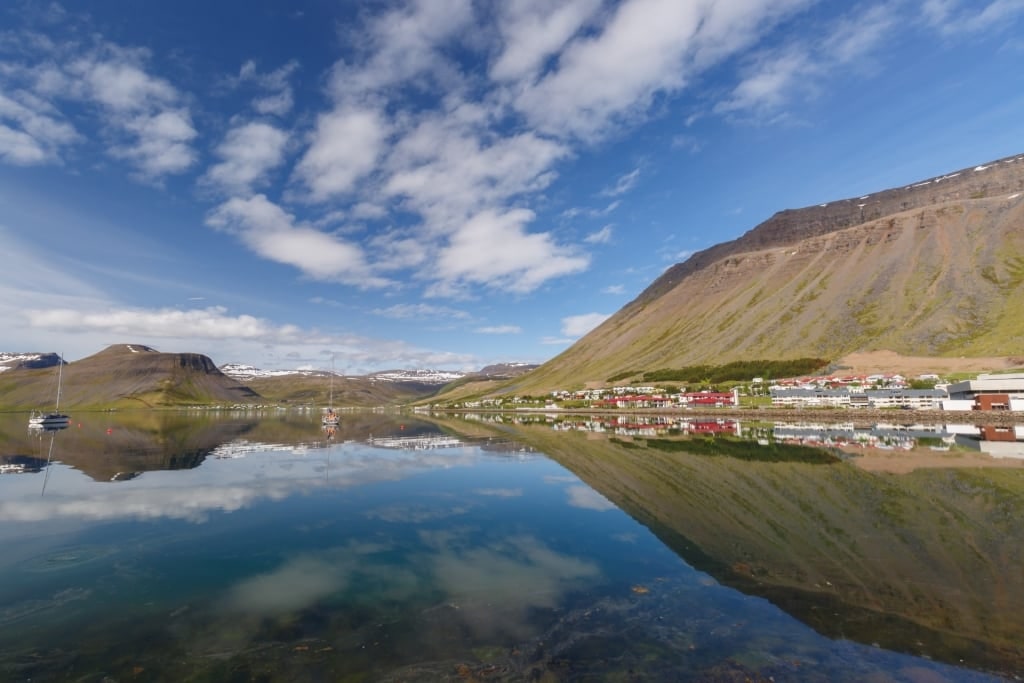
Isafjordur Harbor
Isafjordur (spelt Ísafjörður in Icelandic, and meaning “ice fjord”) huddles at the end of a deep inlet, Skutulsfjörður. Much of the tiny town occupies a curved spit that protects a vast natural harbor.
This topography makes it easy to see why this was such a successful fishing port in the past. Indeed, many of the streets, which are laid out on a grid system, feel as though they’ve changed little since Isafjordur was the epicenter of the region’s fishing industry in the 18th century.
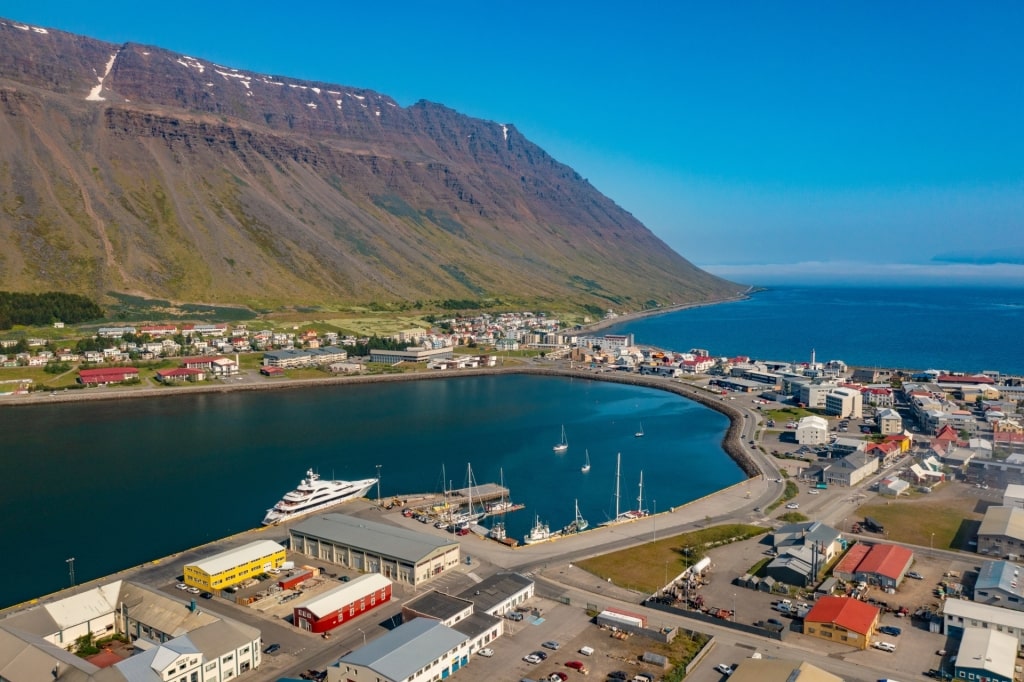
Isafjordur Harbor
Visit Isafjordur to see a different face of Iceland. The Westfjords is entirely different than places like Reykjavik; wilder (if that’s even possible in this starkly beautiful place that’s been shaped by fire and ice), more isolated, and with a real sense of being closely connected to nature.
Go hiking just outside the village, embark on a whale-watching trip from the harbor, or explore the surrounding water via sea kayaking. The Westfjords is also the location of several quirky but surprisingly good museums, artisan food producers, and authentic Icelandic restaurants.
History & Culture
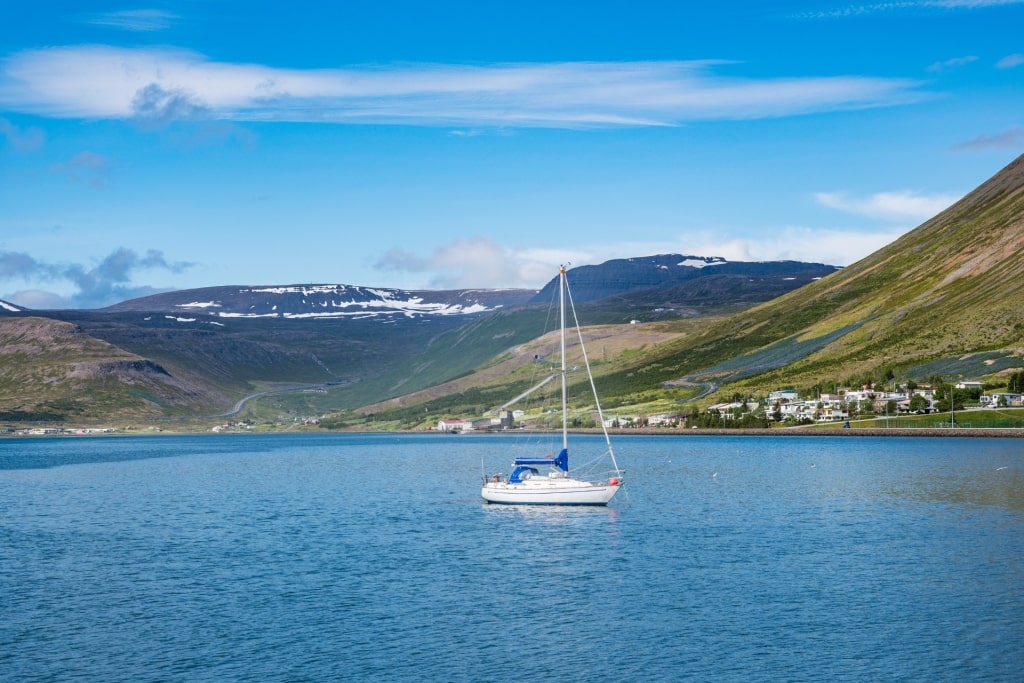
Isafjordur
The Icelandic fjord of Skutulsfjörður, in which Isafjordur lies, is believed to have been settled since the ninth century.
Isafjordur’s protected position and easy access to the sea meant that it grew as a fishing port and trading post, reaching its heyday in the 17th and 18th centuries. In the 20th century, the area fell into decline as fish stocks waned and bigger fisheries from Reykjavik put local enterprises out of business.
The town has since reinvented itself as the capital—and the tourism capital—of the Westfjords, with employment coming from tour operators, hotels, restaurants, and cafés.
Wildlife & Nature
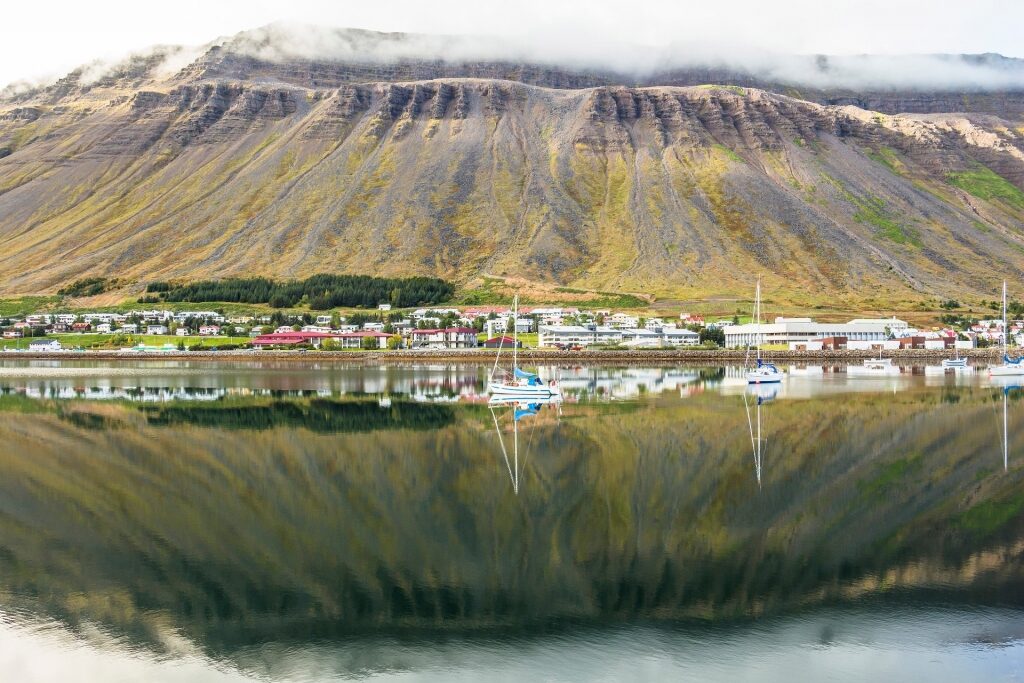
Isafjordur
Isafjordur has a wild, remote feel, surrounded by brooding mountains that have been eroded smooth by glaciers over the millennia. There are no trees to speak of, but in summer, lupins cover the hillsides in a mauve haze.
Everything here is extreme; the sheer cliff faces, the vast tracts of empty hillside, dark fjords, and endless beaches. Foaming waterfalls cascade hundreds of feet over sheer cliffs.
Every drive is an adventure, the coastal road snaking around the contours of the peninsula through endlessly dramatic scenery.
But despite the starkness of the landscape, life thrives here. You’ll most likely spot common and gray seals on the shores, and if you’re lucky, the handsome and jaunty-looking Arctic fox out in the wild.
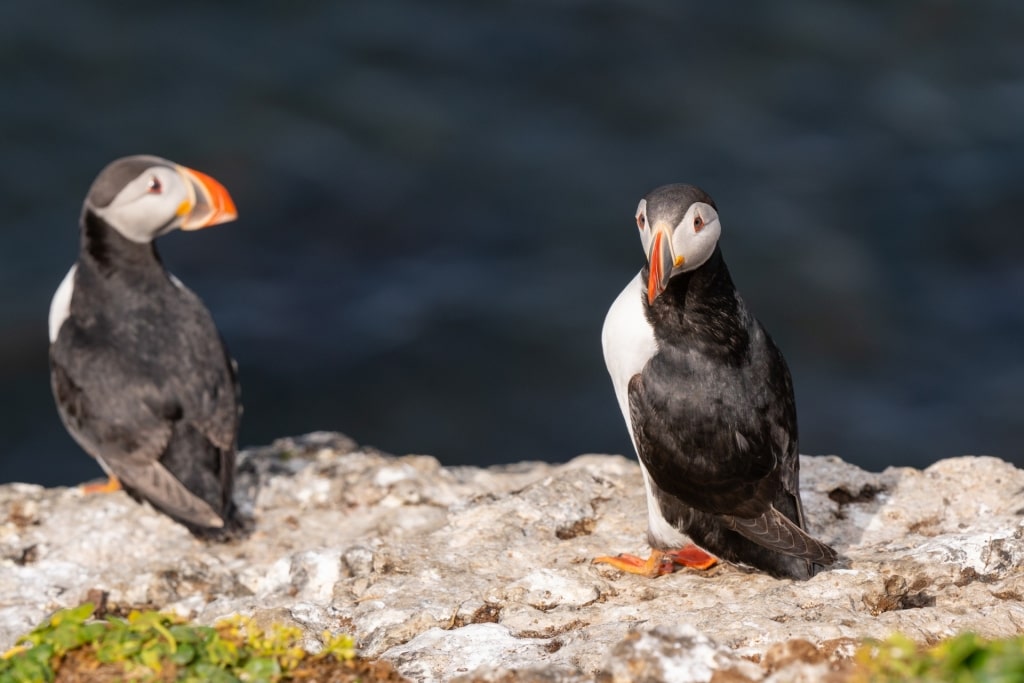
Puffins
More than 50 species of bird breed here in the Westfjords, including eider ducks, teals, whooper swans, and the enchanting puffin.
And since Iceland is one of the best places to go whale watching in the world, boats head out from Isafjordur in search of orca, humpbacks, pilot whales, sei whales, minke whales, and even the majestic blue whale during the summer season.
A word of warning if you head out on a hike. Arctic terns, which nest on the ground in summer, will dive-bomb trespassers who come too close to their nests. It’s quite the experience, being chased by a tiny bird—but the terns mean business.
Things to Do & Attractions in Isafjordur
There are plenty of things to do in Isafjordur itself, although you’ll probably want to venture out of town to immerse yourself in the wild nature of the Westfjords, too.
Cultural House
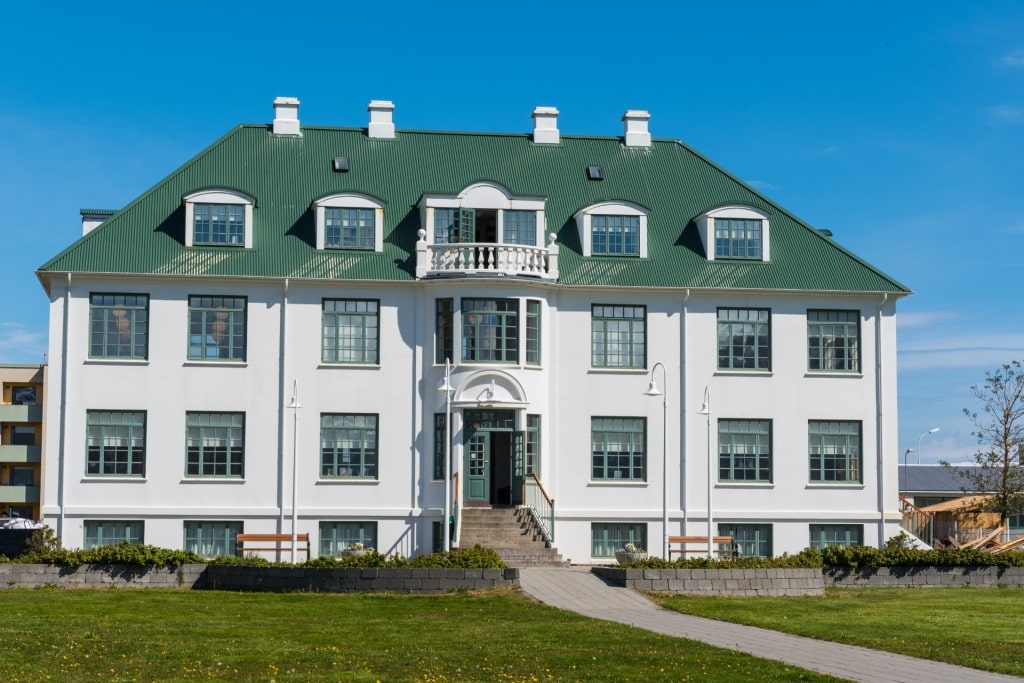
Cultural House
Step back in time into what was once the town hospital, built in 1925. Now, the old building houses a collection of vintage photographs, books, paintings, and archives, as well as temporary art exhibitions.
Hverdags Afn – Museum of Everyday Life
Take a deep dive into the lives of people in the Westfjords in this quirky, gently eccentric museum. It curates what’s essentially the mundane, and tells stories of ordinary people via recorded interviews, everyday items, and a sensory laboratory.
Vigur Island
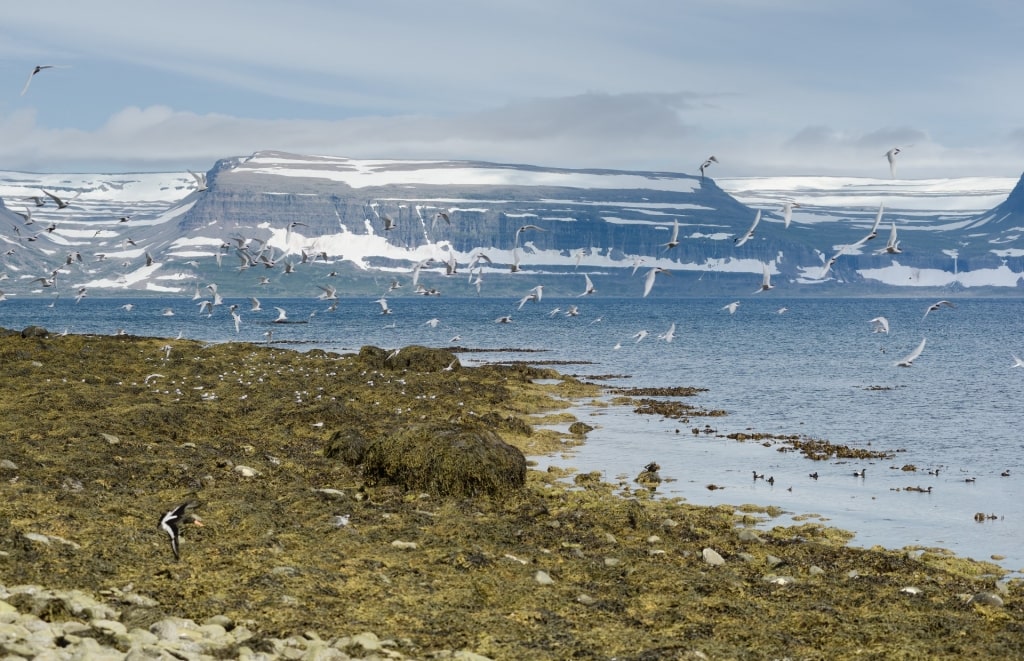
Vigur Island
If you love birdwatching, don’t miss a trip to long, skinny Vigur Island, a half-day boat trip from Isafjordur. One of the most beautiful places in Iceland, Vigur is best known for its birds, which include puffins, eider ducks, guillemots, and arctic terns.
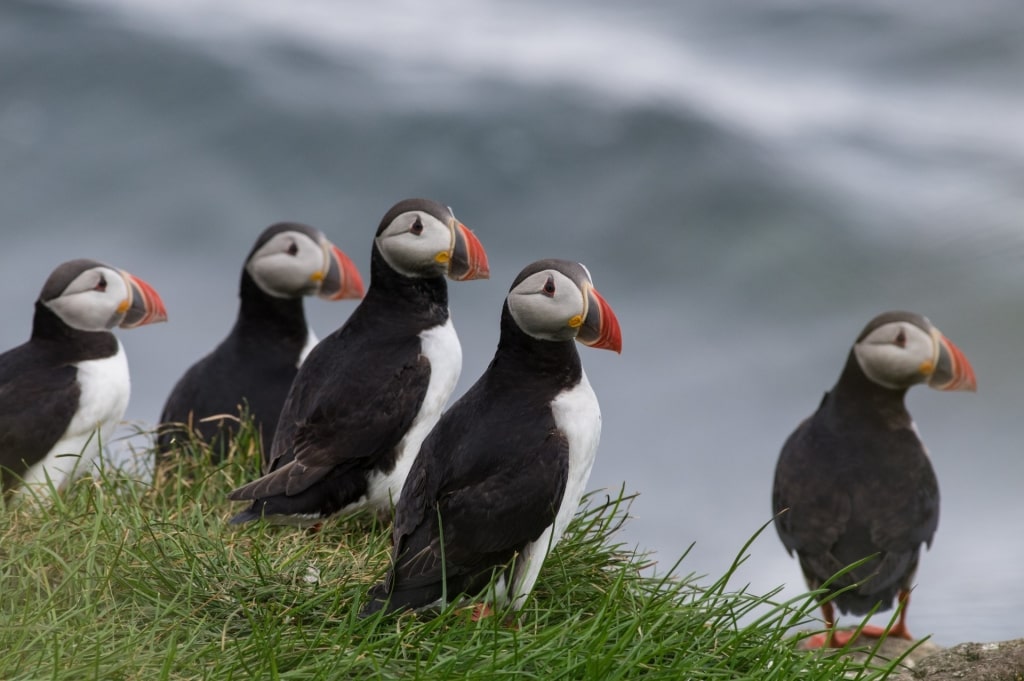
Puffins
Follow a trail to see the puffins, avoiding falling into their nests, which are in the ground. Puffins are not the most agile fliers but have an efficient way of catching and carrying fish back to their chicks; see if you can spot a bird with tiny fish stacked neatly in its orange-and-black striped beak.
Vigur also has the smallest post office in Iceland, some colorful homes, and the country’s only windmill.
Dynjandi Waterfall
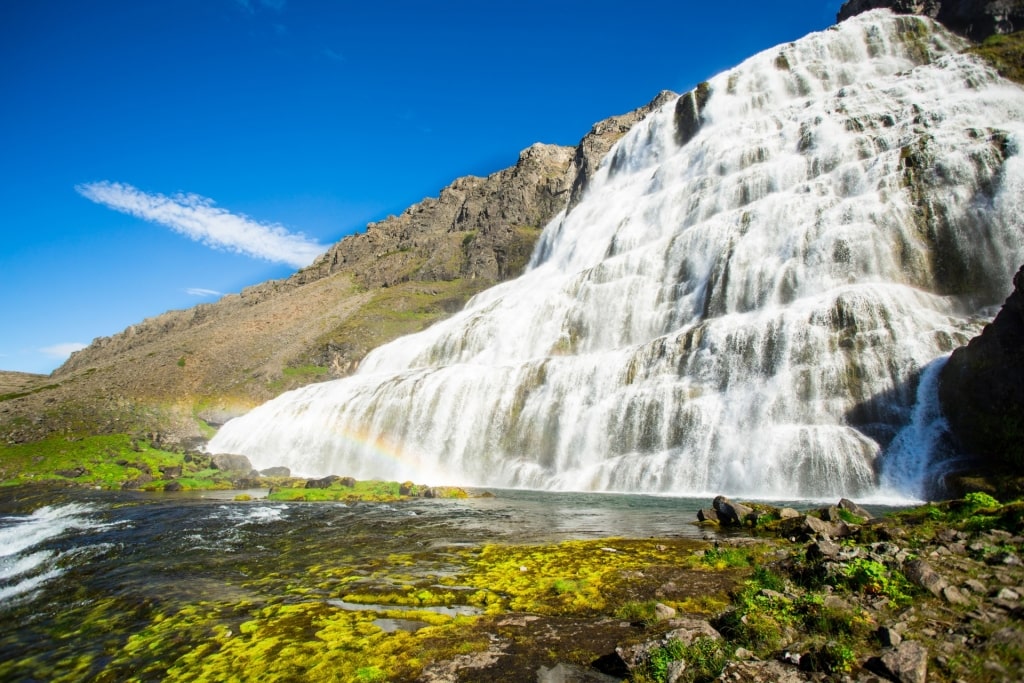
Dynjandi Waterfall
Iceland is known for its waterfalls, and possibly the most famous in the Westfjords is Dynjandi, which cascades over 328 feet down a ridged rock face. The falls fan out like a bridal veil and are much wider at the bottom than at the top.
Seven individual falls tumble over the rocks beneath the main waterfall. There are hiking trails from the parking lot from which you can experiment with your photography skills, or simply take in the spectacle.
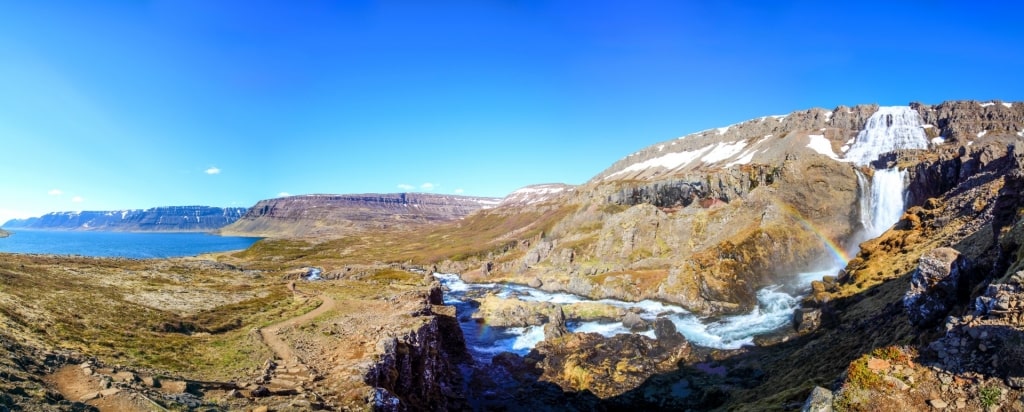
Dynjandi Waterfall
Dynjandi takes the best part of a day from Isafjordur, but every inch of the drive there and back is spectacular. Most visitors combine the falls with a visit to the fishing village of Sudureyri, connected to Isafjordur via Iceland’s longest tunnel.
Bunárfoss Waterfall

Bunárfoss Waterfall
If you want a hike in the countryside close to Isafjordur, head two and a half miles out of town to Burnárfoss, which tumbles in stages over the grasslands of the Tungudalur Valley.
Walk or take a taxi to the Tungudalur campground and simply follow the course of this Icelandic waterfall up the hill for a decent workout and magnificent views.
Naustahvilft, The Troll Seat
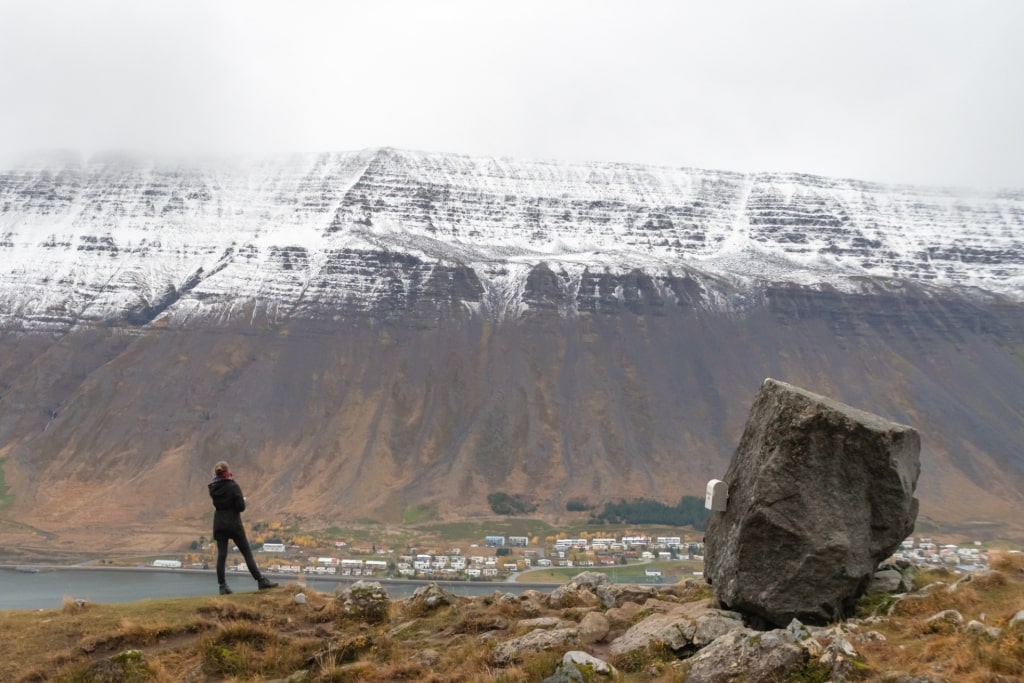
Naustahvilft
Look down on Isafjordur from a different perspective from the Troll Seat, a hanging valley cut by an ancient glacier out of the flat-topped mountains above the town. Like many natural features in Iceland, this one is associated with a legend.
The story claims that a troll was rushing home before the rising sun would turn her to stone. Arriving early, she sat on top of the mountain to rest and cool her feet in the fjord.
The result is the deep harbor, an impression left by the enormous troll’s feet, the curving peninsula on which the town lies, which was the land between her feet, and the seat shape carved out of the hill by her rear.
Whatever interpretation you choose, the hike is steep but rewarding, and the views across the town and the fjord are magnificent.
Westfjord Heritage Museum
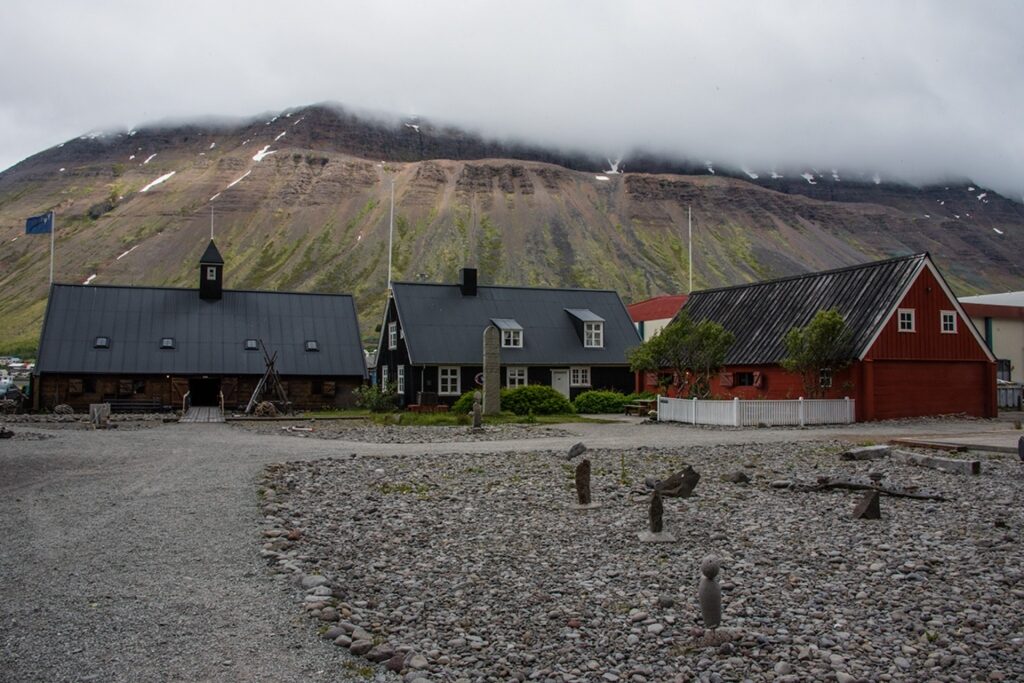
Westfjord Heritage Museum Photo by Emstrur on Wikimedia Commons, licensed under CC BY-SA 4.0
Also known as the Maritime Museum, this is the place to go for an insight into the history of the Westfjords in the context of fishing.
The museum is located in an old warehouse in Isafjordur, built in 1784, and gives a fascinating insight into the lives of fishermen and their families, as well as the boats and equipment that they used.
You’ll get a glimpse into the world of whaling, too, and also be able to visit the Harmonica Museum, which houses more than 220 instruments.
Sudavik
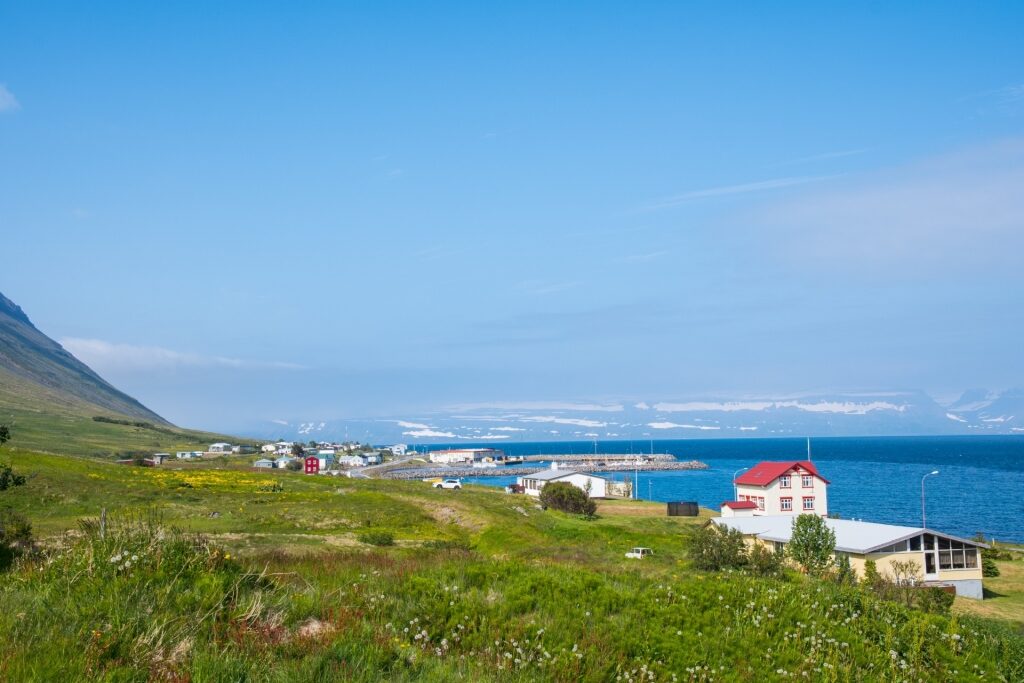
Sudavik
Just 20 minutes’ drive from Isafjordur, around a rugged headland, the little village of Sudavik has a couple of unusual and interesting attractions.
Stop at the chocolatier Saett & Salt, for an unusual gift to take home. The chocolate is hand-made on site using local herbs and berries as flavorings.
The sea salt used in the salted versions is an Icelandic specialty, harvested sustainably from Reykjanes in the Westfjords.
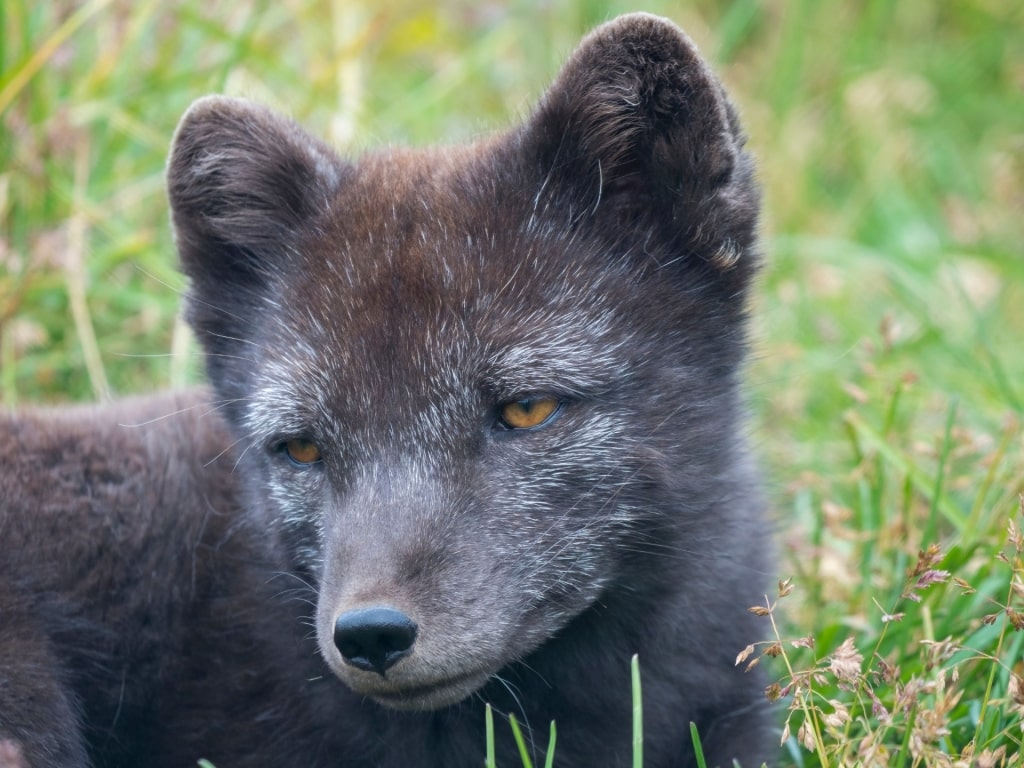
Arctic fox
Close to Saett & Salt is the Arctic Fox Center, located in the oldest house in the village and dedicated entirely to the research and preservation of the Arctic fox, Iceland’s only native land mammal.
You can learn about the life and habits of the Arctic fox and meet orphaned cubs which are cared for at the center.
Food & Drink
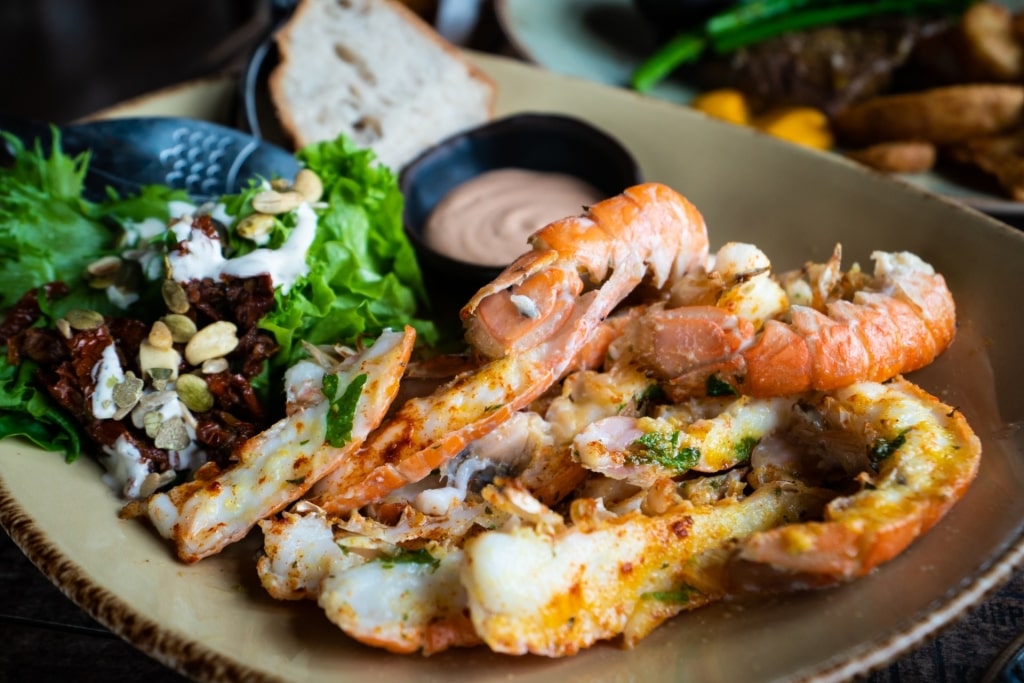
Icelandic lobster
Unsurprisingly, much of Iceland’s culinary culture revolves around the sea. Locals eat fish several times a week and love the local Icelandic lobster, a tender langoustine.
You may see Plokkfiskur on menus, which is a traditional fish stew with potatoes, onions, milk, and seasoning. Lamb comes in multiple forms, including smoked, stewed, or roasted. Reindeer is also popular, as it is in other Nordic countries.
When it comes to street food, Icelandic people love hot dogs, which come loaded with deep-fried onions, ketchup, mustard, and remoulade sauce.
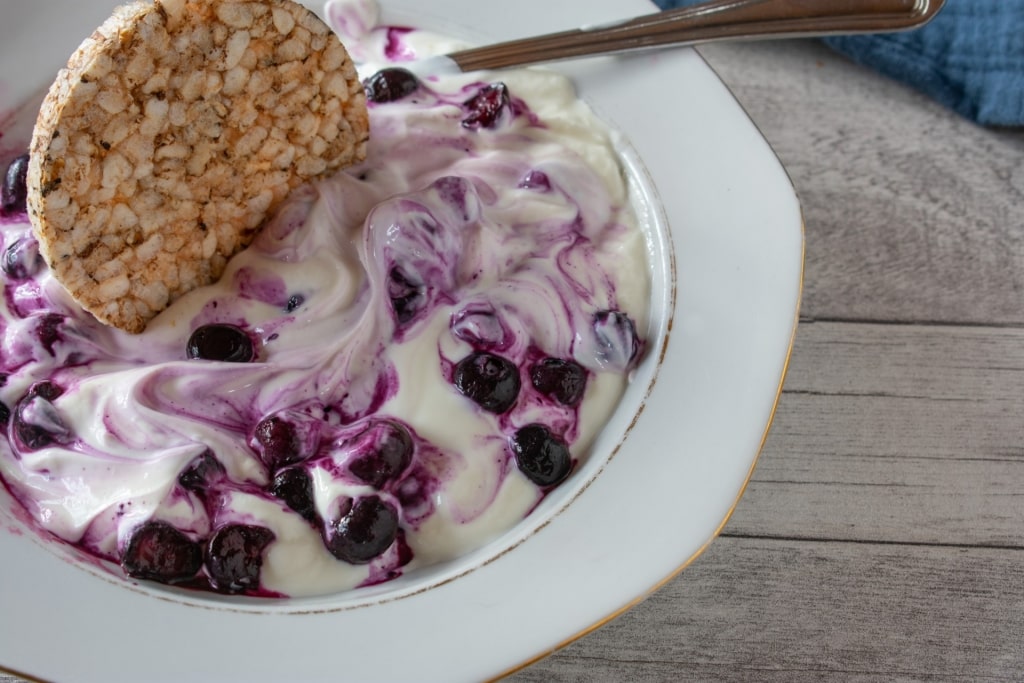
Skyr
You’ll also find summer berries on menus, as well as Skyr, a high-protein dairy product not unlike creamy Greek yogurt, a wide variety of cheeses, and superb ice cream.
Some of the less palatable specialties in Iceland include boiled sheep’s head, puffin, and the infamous fermented shark, which is definitely an acquired taste.
These are very traditional foods; in reality, modern Icelandic haute cuisine is delicate, fresh, and refined, and many wouldn’t touch rotted shark or a sheep’s head.
Isafjordur has a few restaurants worth trying. Family-run Tjorahusid (Tjöruhúsið), located in an old wooden house next to the maritime museum, is packed with atmosphere.
There’s a garden, too, for fine days. You won’t find a menu as only the catch of the day is served.

Lamb
You could also try Vid Pollinn, in the Hotel Isafjordur, for delicately presented local dishes with plenty of fish and lamb on the menu.
Craft beer enthusiasts will be delighted to discover Dokkan, one of the best breweries in Iceland and the only brewery in the Westfjords. Dokkan has been making beer since 2018 on Sindragata in the center of town.
Best Time to Visit Isafjordur
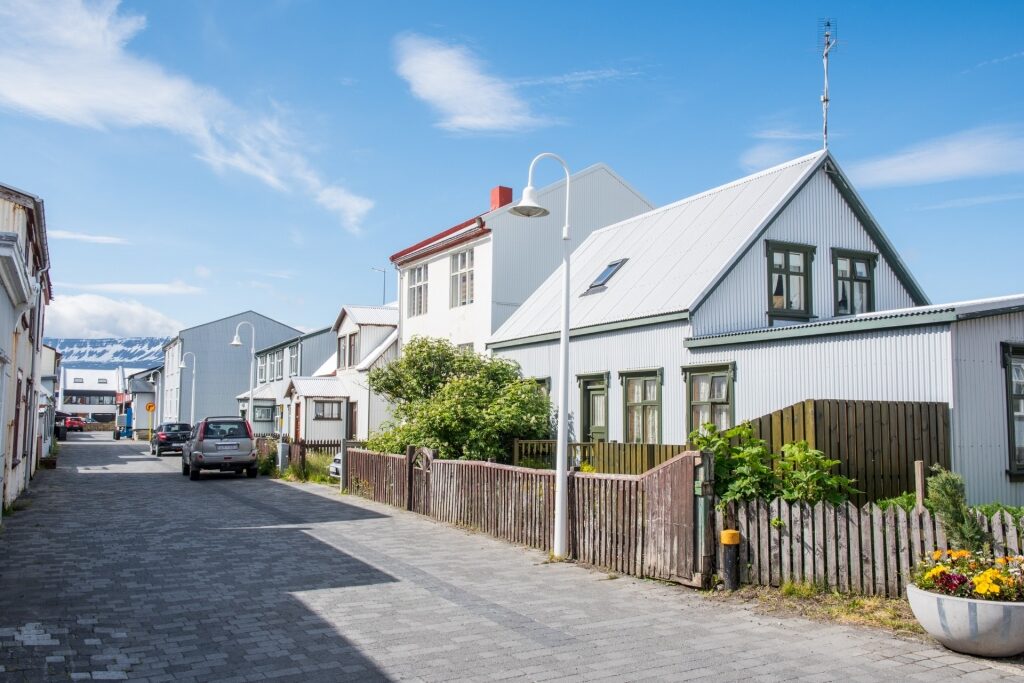
Isafjordur
Summer in Iceland is the best time to visit. The days are long in June and July, with 23 hours of daylight in midsummer. The sun only just sinks below the horizon, and it never really gets dark.
Temperatures are cool, though. Even in the height of summer, you should only expect daily highs of around 50°F (10°C).
One bonus of Isafjordur is that the town is protected by high mountains, so isn’t subject to a relentless wind, which makes sitting in a pub garden in summer all the more pleasant.
When you’re packing for your trip to Iceland, you’ll need to bring windproof clothing, hiking boots, and a waterproof jacket, as the weather can change quickly. Outdoor activities will go ahead whatever the weather.
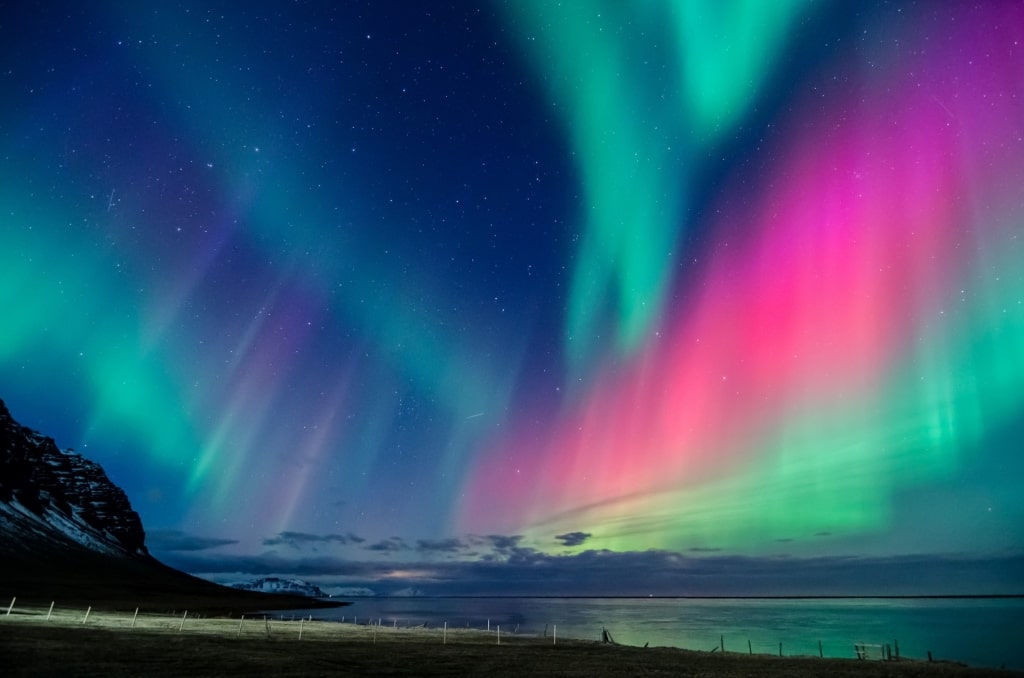
Northern lights
If you visit towards the end of summer, around early September, there’s much less daylight but after dark, an excellent chance of seeing the Northern Lights rippling across the sky.
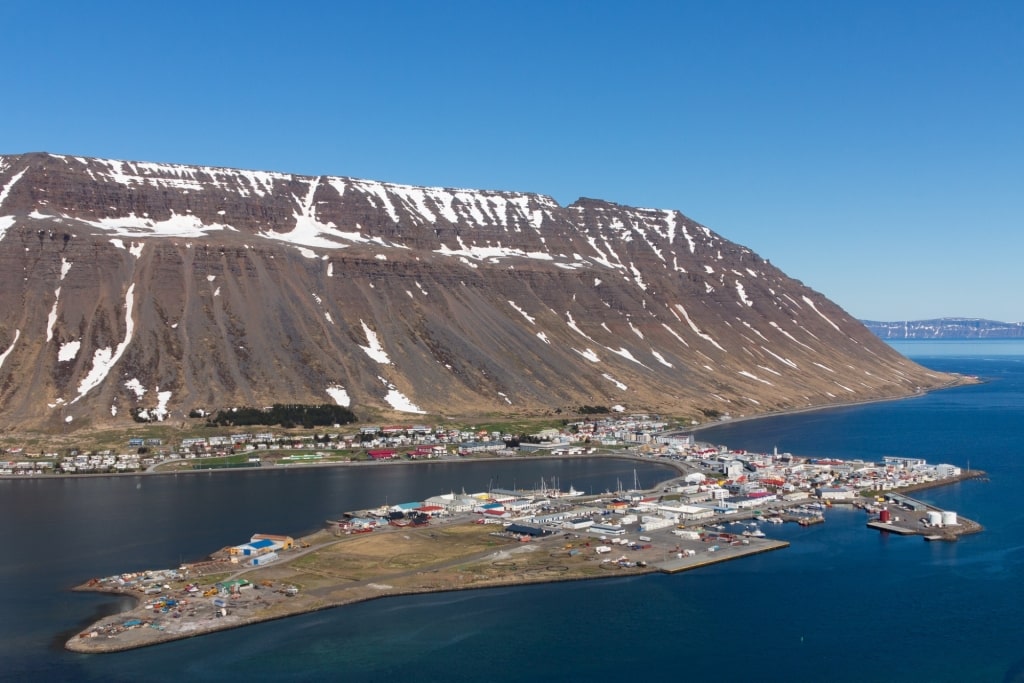
Isafjordur Harbor
Inspired to learn more about the landscapes and legends of Isafjordur, Iceland? Browse Celebrity’s cruises to Isafjordur to plan an exciting cruise to the “land of fire and ice”.
